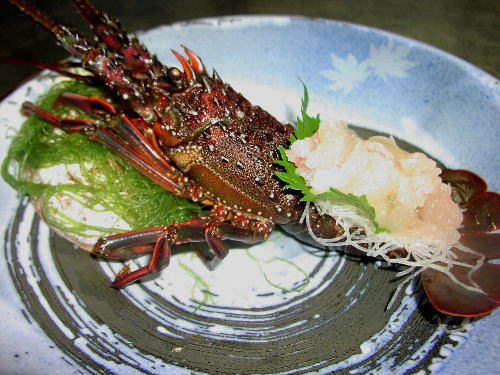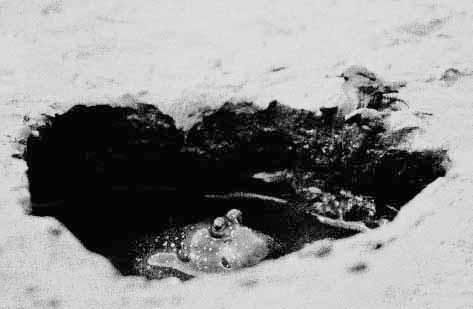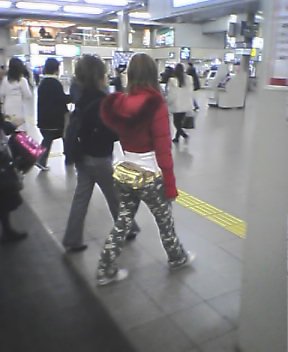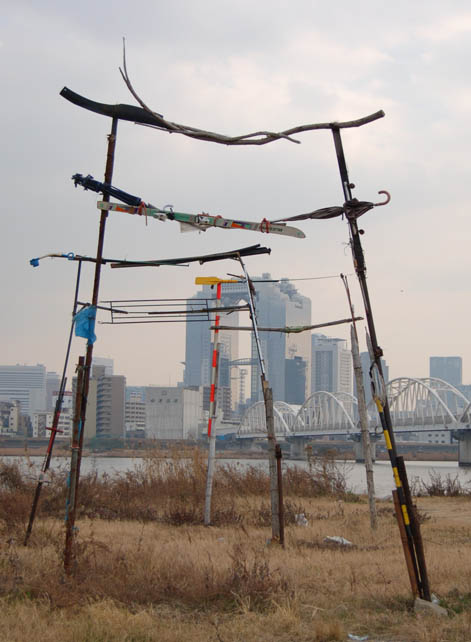January 31, 2006
Across the river from Juso
This is the view from the Umeda Sky Building, which overlooks all of Kita, as well as Yodogawa-ku. At a higher resolution, you can see the tents of the homeless that run along the sides of the Yodogawa.
January 30, 2006
Osaka Homeless: Lessons in Sustainability from the Invisible Caste
Apparently, there is going to be a big, important rose festival and an event showcasing urban greenery (English link) in Osaka later this year. The city officials want to get rid of the homeless in Osakajo park and Utsubo park, where these events are to be held. In order to dismantle the 28 homes in the park and to evict their occupants, about 1,100 workers, security guards, and police were sent in to do the job. Understandably, the homeless and their supporters did not go willingly.
Osaka homeless resist police move (from the BBC, thanks Huw)
Here's an article of information about the evictions in specific, and the challenges faced by the Osaka homeless in general (if you only read one article in this post, read this one):
Urgent appeal from Homeless activists in Osaka, Japan
In this article, the Kamagasaki Patrol no Kai also gives the reader information about what is being done to protest the government.
I think it?s pretty fucking cold-blooded that the city authorities have decided to evict the homeless in the middle of this brutal winter. These are not people who can just pack up and move easily, even when it?s not freezing. I would feel pretty guilty about going to this rose show, knowing that part of the price of admission was paid by people who got kicked out of their homes!
This reminds me of an urban planning class I took at UCSB, when the professor showed us pictures of public benches in cities around America and asked what all of them had in common. ?They?re all designed so that homeless people can?t sleep on them. Next time you?re out and about, look at the designs of the places of the seats.?, he said.
And sure enough, they?re all over the place. Seats are slotted, molded, and partitioned so that you can?t lie across them and benches are curved in a convex contour so that if you were to lie them you would fall off. It?s the ultimate passive aggressive design and it?s invisible to everyone except for it?s targets.
Another article reports a case that may set precedence, for the homeless to be officially allowed to live in the public parks. The Osaka district court recently overruled the Osaka Kita Ward?s decision to reject one homeless man?s registration of his tent in a public park as his address of residence:
"I'm surprised and happy because I did not think I could win," Yamauchi said after hearing the verdict.
"If the ruling is finalized, I plan on applying for welfare," he said.
Yamauchi's lawyer said a person cannot exercise the right to vote or receive welfare, including pension and health insurance, without a residential registration, which means he cannot lead a decent life as a citizen.
(Park deemed tent man's valid address, from the Japan Times via Justin)
I had no idea about the size of the homeless population in Japan, but the BBC article listed a figure of 25,000 people, with a third of them living in Osaka. Apparently, the poor economic performance over the last 15 years has spurred a growth in this demographic.
The homeless around my area maintain gardens, and live a much more sustainable lifestyle than you or I or any average person. The goal of using open green spaces is to create an environment where we can go to feel comfortable, to decompress after spending the majority of our day in a building, surrounded by glass, veneer, cement, bricks, concrete, and barriers that keep us separated from others in general. Urban planners like Frank Lloyd Wright used these areas to help bring nature into an environment that has been sterilized of it, as a place to allow people to enjoy the outdoors together in these commons.
The city officials are kicking out the very people who are living more at harmony with the landscape and urban environment than any other segment of the population. I wonder if they have ever though about where all the trash in the parks comes from, and what demographic abuses the commons the most. Can you guess where the bulk of the garbage next to the Yodogawa comes from?
It comes from people who visit it on the weekends, from upstream, from those damn teenagers and salarymen who eat their convenience store bought snacks and cigarettes and don?t bother looking for a trashcan, and from people who illegally dump their waste on park grounds in order to avoid paying a disposal fee.
It?s the homeless people, the ones who live in these commons, who pick up after the visitors after they go home. It?s the homeless people who ?Reduce, Recycle, and Reuse? other people?s refuse to make or maintain their shelters. Hell, the homeless even maintain extensive flower beds next to the Yodogawa, adding color to an otherwise unremarkable patches of land.
The best way to get a feeling for how remarkable a life that these people live is to go out and visit these places, and that?s just what Justin, Nam, and I did this weekend. We walked along the Yodogawa and checked out some of the tents up close:
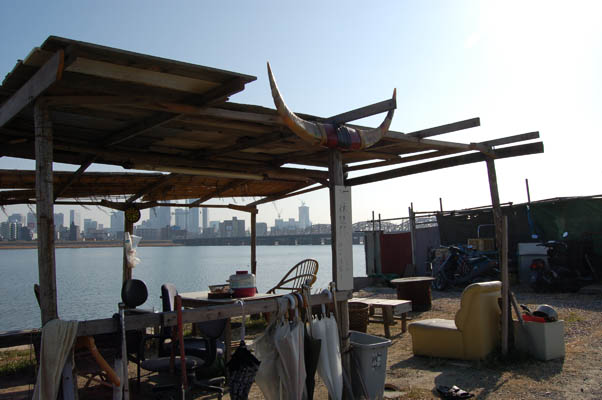
(click on picture for a close-up of the sign, photo by J. Yoshida)
This is an awesome outdoor space that some homeless dude set up next to his tent. The sign says that anyone can use this area! It?s funny how we, the ones with money and property, post signs to drive people away. I might just throw a barbecue party here before I leave, no joke.
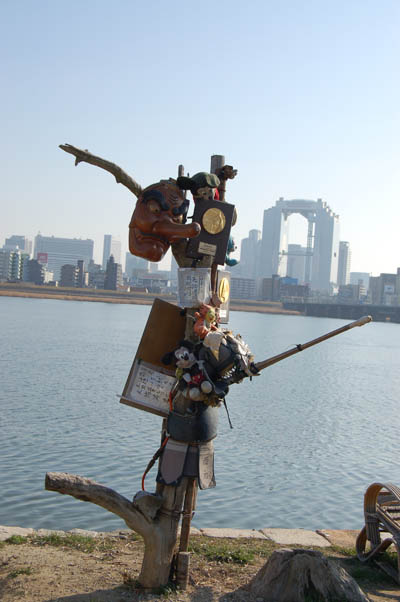
An example of inner city beautification, not paid for by Japanese tax dollars.
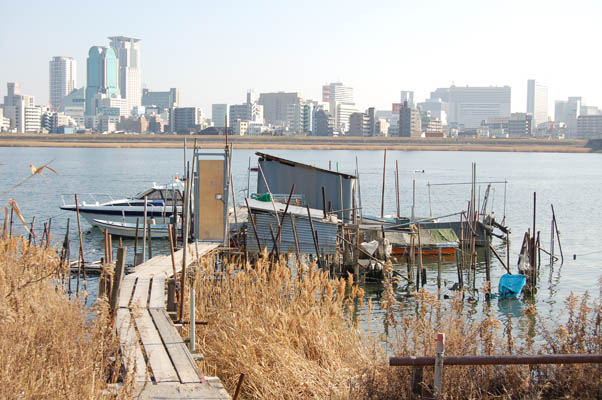
(photo by J. Yoshida)
The homeless make use of all available materials. They also seem to own their own boats!
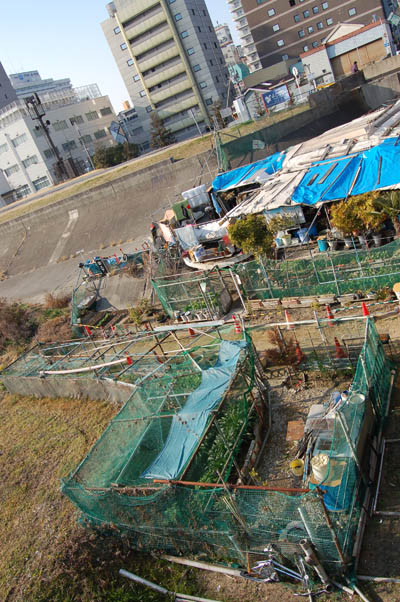
These (private) gardens are meticulously maintained, and it looks like leeks, onions, lettuce, and other leafy vegetables will be on the menu this winter. This dude puts the UCSB Environmental Studies major hippie communes/cooperatives to shame! This is sustainability. Did I mention that they sell fishing bait here as well?
As I mentioned before, I will be posting more pictures on my Flickr page so check back once in a while for updates.
Also, I was wondering, is there any other way besides 家のない (ie no nai, or without a house) and安息の場を与えない (ansoku no jou no ataenai, or without a place to rest) to say ?homeless?? Was there a time when saying these words required more of an explanation if you used them in a conversation? Surely a loanword will come into use as the homeless population and issues dealing with them continue to grow. Or maybe not. After researching this topic more thoroughly, it looks like the same things happen and are breifly reported in the news year after year with nothing much changing. Homeless will likely stay "a person without a home" because no one wants to think about them, let alone deal with the problem.
Further Reading
Shannon Higgins tells the story of Japan's largest slum in The Kamagasaki Gallery
Oyama Shiro's book A MAN WITH NO TALENTS: Memoirs of a Tokyo Day Laborer
The Streets of Osaka as documented by subjectivite.net
An excellent BBC pictorial on Japan's homeless, with interviews
This article by the Cristian Science Monitor explores the link between ageism and the homeless in Japan
Artist Geoff Reed's Face The Street
Andreas Seibert's photos of the homeless in Osaka
Not everything tastes like chicken
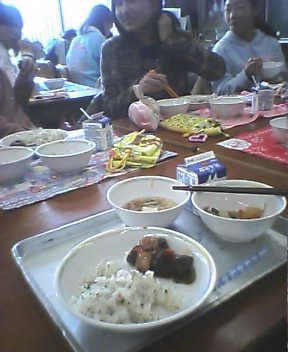
I?ve been lucky to have been stationed at schools that have their own cooking facilities on school grounds, so everything has been freshly made. As a bonus, kyushoku is cheap (220 yen for a lunch at my current school), and seconds are often available for those who want more.
The task of serving school lunch is delegated to the students, who carefully portion out the food. At the end of the designated time that they are allotted to prepare lunch, a student reads off the menu so that every one can check to make sure that they have everything that's supposed to be there and also to let every one know just what it is that they will be eating.
On this day, I was talking to my students and ignoring the announcement when I heard ?blah blah blah?kujira?blah blah?, and took a second look at the sweet and sour ?pork?. I tasted it, and it was almost identical to the generic sweet and sour pork that you can get at any Chinese restaurant, except the meat wasn?t as fatty. Although delicious, this particular kyushoku made me agitated.
Why would you use whale meat to make a dish that tastes better with pork anyways? Whale meat is certainly more expensive than pork, and there must be other ways to prepare it so that you know you?re eating whale. It just seems like such a waste, even if you ignore the ethical implications of eating large marine mammals. The whalers went through a lot of trouble to file the paperwork to harvest the whale for ?scientific research purposes? and to harpoon the damn thing, so why did they make the whale taste like pork?
Another thing bothered me about the whale. I didn?t feel bad. At all. I chewed it, and though images of Greenpeace, mortally wounded whales floating on a patch of red brine, and other things passed through my mind, it didn?t make me disturbed in the least. All I could think was, ?Wow, this tastes like a lean cut of pork?.
I was curious to know where this whale was from and what type of whale it was. What species was it? Was it a toothed whale or a baleen whale? Where was it caught? How was it captured? The sad thing is that no one ever knows where the whale for our school lunches comes from. They know more about the beef, milk, and vegetables than the whale!
January 29, 2006
Gyoza and beer 盛り合わせ
Friday night started out with a trip to go buy enough gyoza for 6 people, meaning 36 garlic stuffed pot stickers, and five tall cans of premium Japanese beer. Once in a while, Osho has a half-price sale on gyoza and people line up outside in a long queue, braving the elements to secure these much-coveted snacks.
I had seen the 105 yen (half price) for a six pack of gyoza advertisements since I've been in Juso, but this is the first time that I actually went out and bought some. Even with two people, it was difficult to make it through all of the gyoza but we managed.
Next week, there's another sale on Saturday so if you're around, please let's enjoy beer and gyoza party in Juso!
January 26, 2006
Natsukashii Kumamoto
Mark has a nostalgic post about Kumamoto, along with a nice spread of pictures to illustrate what life on JET was like during our stay (and what it will probably be like for many years to come).
It got me thinking about what a great time I had down there. It's hard to organize the things that I've seen and done down there. This is the most clear and concise way that I could think of quickly cataloguing my experiences:
The Kumamoto Top 5s
Top 5 Hikes
1. Kuju during the winter and spring
2. Aso-san at night
3. Kikuchi gorge
4. Yamabuki suigen when the fireflies are out/ Yamabuki suigen with fresh snow
5. Daikanbo on the Milk Road
Top 5 near death experiences
1. Playing with mamushi
2. Mark getting guillotined by Deez Nuts
3. Driving the Milk late at night in thick fog
4. Driving without a blinker due to Dukes of Hazard entry gone wrong
5. Almost driving off a cliff in Ashikita with Deez Nuts
Top 5 parties
1. Jason's house on any given weekend during the first year
2. Hanami at Kumamoto Castle
3. Waterwheel
4. Any night after a hash
5. Hanami in Ubuyama
Top 5 excuses to get out of work
1. SARS
2. Tori influenza
3. Buying teaching materials
4. Going to a "meeting"
5. A byoukyu surplus
Top 5 perks of JET
1. Recontracting conference in Kobe
2. Mid-year conference in Kumamoto City
3. Free Japanese lessons
4. Loads of nenkyu, raikyu, and byoukyu
5. Meeting cool people from all over and making fun of NOVA people (haha, those guys suck!)
Top 5 foods
1. Tonkotsu ramen
2. Basashi
3. Masa's hamburgers
4. Iseebi sashimi
5. Karashi renkon
5 things I never ate in Kumamoto
1. Inoshishi
2. Kuma
3. Kiji
4. Koi zushi
5. Mamushi
Nastiest 5 drinks
1. Anything from the Sanctuary Bar
2. Flaming doctor peppers
3. Jack Daniels and Contac cold medicine
4. Cheap straight shochu
5. Old, warm happoshu
Top 5 surrounding prefectures and their best attraction
1. Fukuoka- Fukuoka city
2. Saga- Nanayama-mura
3. Miyazaki- The gorge
4. Kagoshima- hiking Kaimon-dake
5. Oita- the aincent Buddhas
Top 5 Onsen Spots
1. Kurokawa
2. Ashikita
3. Ubuyama
4. Kikuchi
5. Kumaden plaza's rooftop onsen
Top 5 menacing/disgusting animals
1. Mamushi
2. Mukade
3. Gejigeji
4. Ao mimizu
5. Roadkill (tanuki, itachi, dogs, cats, and snakes)
Top 5 animals that make you hungry just looking at them
1. Cows
2. Horses
3. Yellowtail
4. Pigs
5. Ayu
Top 5 matsuri
1. The Kagura festival
2. Hifurishinji- the fire swinging festival
3. Drunken horse festival in Kumamoto City
4. Yamaga Lantern festival
5. Kyokushi's beef festival
Top 5 flowers
1. Higothai
2. Nanohana
3. Fujinohana
4. Sakura
5. Ume
Top 5 places to go on a date
1. Picnic at Kikuchi Gorge
2. Party at Ashikita
3. Drive on the caldera
4. Hitting izakaya and hidden Japanese bars in Kumamoto City
5. Hashing
Top 5 things that happened while hashing
1. The hash organizer's hand getting cut due to leaning on a window and breaking through, resulting in a permanent "thumbs up" for several months afterwards, and still running the hash.
2. A shoe getting irretrievably buried in cow shit, and then running the rest of the hash barefoot.
3. Wading through cow shit-laden water in Kyokushi (notice a trend?), and then watching the faces of the workers at the onsen as a group of nasty gaijin bum rushed the facilities.
4. The showing of various body parts at religion, and punative drinks given as a result of mistreating the Chalice.
5. Austin cannonballing the hood of a random person's car as she was driving down a street next to the Shimatori.
In case you couldn't tell, I think that Kumamoto, and Kyushu in general, is one of the best places to live or visit in Japan. The big cities and famous attractions of Japan are cool as well, but there is a feeling of timelessness that I have only experienced in Kyushu, Kumamoto in particular. It's because things aren't as convenient, cutting edge, or fast-paced that life is more adventurous, intimate, and pure in the country side. I hope that Kyushu stays just the way it is, and I think that it just might.
January 25, 2006
Jack Bauer Facts
"Upon hearing that he was played by Kiefer Sutherland, Jack Bauer killed Sutherland. Jack Bauer gets played by no man."
January 24, 2006
Where I reside
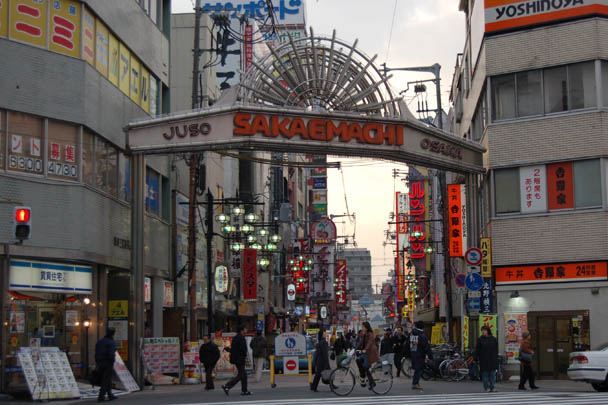
I live in Juso, a place whose name can be written shorthand as 13. When I moved from Ubuyama, I wanted to live in a place that was the polar opposite of where I spent my first two years in Japan. I really couldn't have found a place that was so foreign to the Japan I had gotten to know intimately within the same country.
It is interesting to note that a good number of people, even those who live near Juso or who regularly transfer trains in the Hankyu hub, have never been out and about in this area that?s just across the river from Umeda. They have a mostly negative view of the place. Juso is associated with lewdness, strange or handicapped people, danger, and dirtiness. Make no mistake, these things do exist here, but it's pretty tame if you've been traveling anywhere outside of Japan.
It's strange to see how the seasons affect people around here. The crazy people and perverts seem to be warded off by the cold, so the girls who live in my apartment haven't come by and asked if they can chill in my apartment for a while because some strange man was following them home (this happened quite frequently during spring and summer).
It's strange to see how skirt lengths get shorter despite the freezing winds whipping through the street.
It's amusing to see the teenage guitarists and their fan girls hanging out under the tracks of the Juso eki, and drunken salarymen occasionally drop a few thousand yen to play a request.
It's cool to see how well the homeless are getting along without any help from the outside world.
It's annoying to see 10 cops standing on a side street with whistles in mouth and pens in hand, ambushing passing cars to ticket drivers.
It's nice to hear the high school band practice next to the Yodogawa as the sun sinks into the West.
It makes you realize just how cold it is when you see the plumes of smoke coming out of the vents of the restaurants, stalls, and off of grilling takoyaki in the morning and at night. Oh, and the snow makes it abundantly clear too.
It's cool to know that if you want to buy a specific type of egg from a specific type of chicken, quail, or even duck, there is a store at the end of the shotengai where you can probably find exactly what you?re looking for.
It's an especially good sign to see that many of the izakayas and eating establishments are regularly crowded with blue collar workers, enjoying their food and drink after work to the point where you aren't always guarenteed a seat. It's also a good sign that not many young people come to these restaraunts- they go to the fancier, more expensive ones in Umeda or Minami instead. They don?t know what they?re missing.
It's nice to exchange "Ohayogozaimasu", "Ittarashai", and "Ittekimasu" with the old lady who lives in the house next to my apartment every morning on my way to work.
It's gratifying to hear people say that they like Juso, after actually coming down here and spending some time and getting to know it. It isn't a touristy area, nor is it a really happening place to be, but it has a nice balance hidden below a scruffy, slightly notorious surface. It is surprisingly quiet at nighttime.
Sure, there are some unpleasant or provocative things about Juso, but at least it is advertised clearly out in the open. It's no more a corrupt or dirty place than the surrounding areas, it's just more honest.
January 23, 2006
Good Snowy Weather
This morning, I woke up refreshed, dusted the crusted snow off of my drying towel for my morning shower, and then skated in the slush to work feeling that today would be a good one for taking pictures. I didn't capture any of the snow before it melted, but saw some cool stuff after I got off of work.
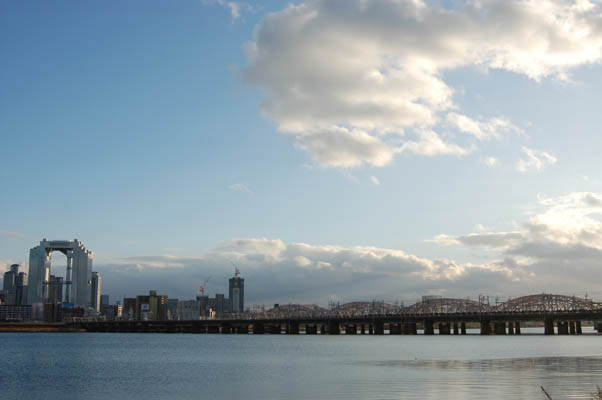
It?s amazing to see snow, rain, or whatever form precipitation decides to take, fall as the sun is shining. Today, from across the Yodogawa, I could see the snow descending on Kita, sweeping across from Hep 5 to the Sky Building. This, I though, was better viewed from a distance in the warm sunshine.
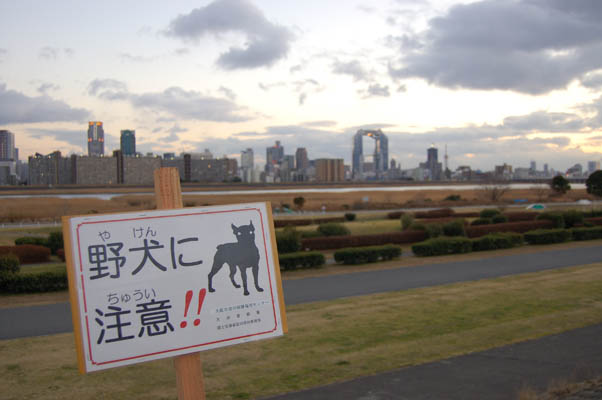
The wild dogs were out again today, roving around in packs. This is a sign warning people about them. Other signs were equally disturbing: One made a plea to people not to abandon their dogs in Yodogawa park. It said ?Dogs are nice animals. Don?t buy pets if you can?t take care of them.?. I don?t think that these signs actually change anyone?s mind about what is right and wrong. It?s hard to convert an asshole into a good person, though I wish the same could be said for the reverse.
Here?s a flyer about dogs posted over one of my favorite signs:
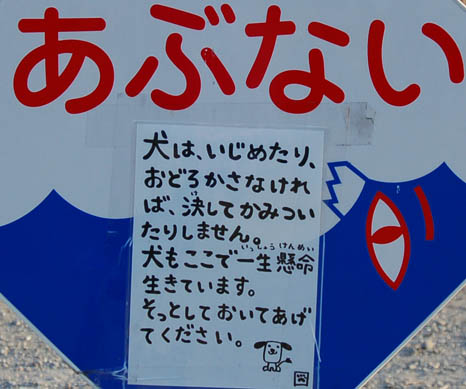
The gist of it is (correct me if I?m wrong) that you shouldn?t be mean to the dogs or surprise them, or they might bite your ass. The dogs are doing their best to live here so be gentle towards them.
It is wrong how pets are dumped in the woods (or next to the Yodogawa for that matter) if their owners get bored of them. If you drive around the country roads of Japan for any length of time, you will see lots of puppy road kill, and if you walk around in the mountains you will probably have to fight the urge to take a whimpering pup home with you. People should have to prove themselves worthy before they are allowed to have kids or pets. And if they fuck up, they shouldn?t get a second chance. Having kids and pets is a privilege, not a right.
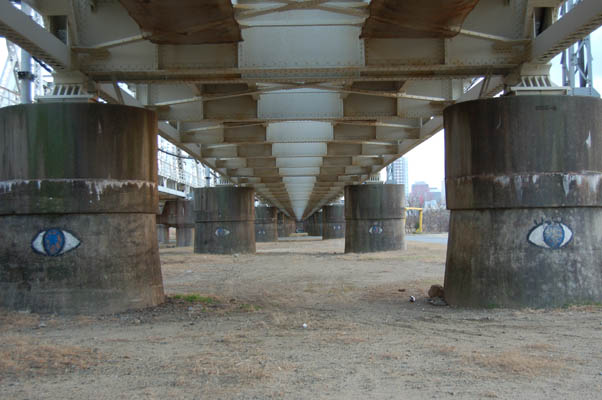
Under the JR bridge on the Shin-Osaka side of the Yodogawa, the pillars have eyes. I wish that these guys would tag more, instead of the delinquents who like to scribble on their territory much the same way that a dog raises its leg.
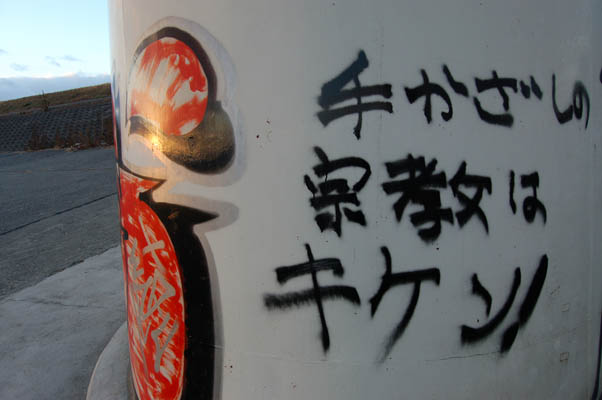
This graffiti is cool because it is dispensing some useful information: beware of religious charlatans (who hold their hand up to your head, and then claim that you?re cured, or something to that extent).
I prefer the country to the city, but living in Juso is actually pretty cool sometimes. Not only is it convenient to get to and a good place to find some cheap, authentic Kansai cuisine, but there are just so many interesting things to be seen around here.
January 22, 2006
Bridge to Awaji-shima at night
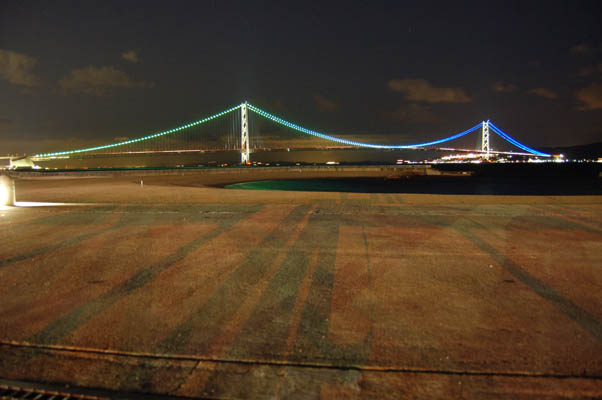
This is the Akashi Bridge that connects Awaji-shima with Kobe, as seen from the Akashi side. It doesn't look like it in the picture, but the sky was pretty dark, and you could just barely make out the beach in the dim light.
I didn't have a tripod, so I rested it on a bench. Unfortunately, a stiff, cold wind was blowing, there was a lot of light from multiple sources polluting the area, and the shutter was open for too long (about 10 seconds or so) for this picture to come out as clearly as I would have liked it to have.
Well, I guess it's time to study up on night photography and hopefully I will have some better pictures to post shortly. I don't think I'll be returning to photograph the Akashi bridge because it's too far away. Justin, you're on this.
January 21, 2006
Thinking about edible marine organisms
(Porcupine fish are abundant off of the Ryukyu Islands- this is one that I saw on a dive close to Zamami island)
*Fugu is delicious, but how many people had to die before a safe technique was developed to separate the poisonous bits from the delicious, slightly toxic but safe to eat parts?
*How many sushi chefs have died after eating the liver of a fugu because they erroneously believed that they had built up an immunity to the toxin, or were egged on during a drinking session by the rest of the kitchen staff?
*Does anyone eat its cousin, the porcupine fish? It would make sense that something that is even more of a pain in the ass to catch and prepare would be even more delicious.
*It?s going to be hard to convince the Japanese in particular that it is in their best interest to cut down on the rate of seafood consumption. Even if they concede that it is necessary need to do this to protect the long-term interests of everyone regarding the declining stocks of fish, there is going to be some serious reluctance to comply with what is necessary. If they actually do cut down, I don?t want to be there to witness the withdrawal symptoms of Japan.
*Even discounting the fact that uni is sea urchin gonads, it is still disgusting. Admit it, it looks and has the consistency a baby turd.
*If you go to any Japanese aquarium and listen to the people around you, you will almost certainly hear someone say "oishisou" (that looks delicious). I wonder if they feel the same way when they visit Sea World and watch the Shamu show...
*Korean nori kicks ass! So do the technologically advanced wrappers that keep nori separate from convenience store onigiri until right before you eat them. By the way, if you?re lucky, you can sometimes find spam musubi in Japanese convenience stores.
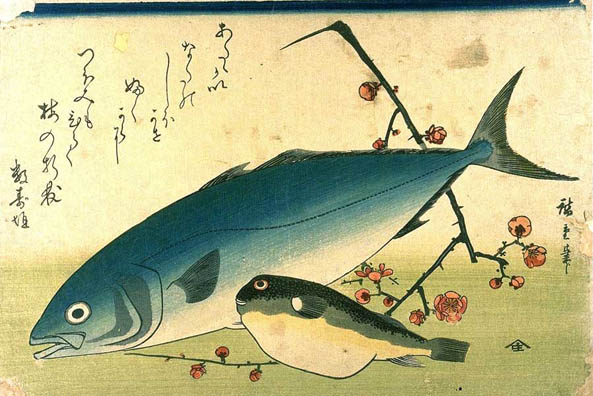
(Woodblock print by Hiroshige Ando)
*It's cool how the yellowtail has so many names in Japanese:
aoThe names vary depending on the size of the fish, the location where the fish is caught, and also are the result of different dialects. Obviously, the people who came up with these names obviously really loved this fish. I would have never known how delicious it could be if the only yellowtail I had eaten was the stuff we catch back in California, though that stuff isn't bad. In my opinion young Japanese yellowtail from cold waters make the most delicious tsukuri, Broiling the collar with a bit of salt is simply heavenly.
buri
hiramasa
inada
fukuragikando
kanburi
kozokura
mejiro
tsubasu
wakanago
wakashi
warasa
*It has been my experience that a restaurant that sells high-quality maguro and hamachi sashimi will inevitably sell out of the hamachi first. Maguro is good, but not a good enough substitute when you are really craving hamachi.
*If people looked like what they eat, then Osaka station would resemble a massive kaiten sushi restaraunt.
*Which lobster variety makes the best ise ebi sashimi? The best stuff I've had so far was from the relatively warm waters of the Amakusa Islands in Kumamoto. However, fish tend to taste better from colder waters, and lobsters lose their firmness of flesh as they get older. So would a young Maine lobster be even more delicious than one from Amakusa? How does Okinawa's ise ebi compare?
*Ordering "tsukuri" sounds cooler than ordering "sashimi", but people in Tokyo won?t know what the hell you are talking about.
*I wonder if people who regularly eat the clams from the Yodogawa are suffering any reproductive problems.
*I have been told that a really good way to catch unagi is to put an ayu in a two liter bottle and place it in a river with the mouth facing upstream. Unagi, it was explained to me, find ayu irresistible and once they squeeze into the bottle and eat the fish, they are unable to get out again. This reminds me of how some monkeys are easily trapped. Rice is put inside a hollow coconut, and when the monkey grabs onto the rice, they can?t pull their fist out of the trap. If they would only let go of the rice, their hand wouldn?t be stuck, but apparently monkeys like rice that much.
*Japanese people get confused when told that the jinbeizame (whale shark) is a fish, and some of them think that dolphins are fish. This never fails to be amusing.
*If you go swimming off of the coasts of Kyushu, don't worry about the clear jelly fish so much. It's the ones with red stripes that hurt like a bitch!
*Mutsugoro (famous in Saga-ken) is hands down the worst tasting fish I have ever eaten. If you can taste mud (a mutsugoro is a mudskipper btw) through a thick layer of teriyaki sauce, there's probably not much that you can do to improve the flavor. The second and third most repugnant marine organisms I?ve tried in Japan would have to be hotaru ika (firefly squid) and fermented whale, respectively.
*I don't like eating small fish that are candied and hard. It feels wrong in more that one way (link to small dried fish).
*Squid kicks ass in so many different ways: calamari rings with spicy salt, battered and fried in tonkatsu, tempura, and fish and chips style batter, dried, dried and coated with honey, cut up as sashimi, or even fried up as a steak or sauteed with some vegetables. It also makes a very handy all-purpose saltwater bait.
*The sushi with crunchy, yellow roe is nasty. Try some next time!
*Japanese salmonids (this includes both trout and salmon) taste a hell of a lot better than the stuff from America. For example, you can stick a skewer through a live Japanese trout, put some salt on its writhing body, broil it over some coals, and come out with some awesome fish on a stick. You can't do this with trout back home and expect it to taste good. I wonder why this is.
*Of all the seaweeds, hijiki will supposedly make your hair the most beautiful.
*Do most people who claim to like hakarl (rotten and mouldy shark flesh) really enjoy it, or is it mostly a way to prove one's virility? Considering that it is traditionally washed down with a drink nicknamed "Black Death", I am leaning toward the latter explanation.
*Has anyone calculated the number of chirimen (tiny fish generally used as a condiment for rice) eaten in Japan in an average year? I am guessing that it?s around jucchopiki (ten trillion). How about for aji?
*What do Gharabaldis taste like?
*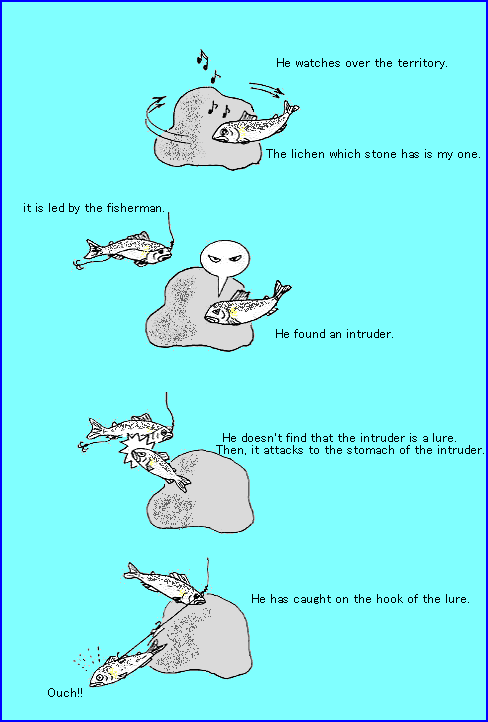
(link)
*Ayu fishing seems cruel and inhumane, though it is a very clever way to catch a fish that would otherwise be very difficult to catch on rod and reel. Ayu don?t eat bait, but they are territorial fish, so if one ayu intrudes the territory of another, it will ram it. Japanese fishermen figured out that by attaching hooks to the body of a ?rival? they could use a live fish as a lure. In order to attach the rig, you must perform some pretty serious pierce work on the fish that you will use. If you do go fishing for ayu there is a right way to set up the rig. If you cover the eyes of the fish while you are attaching the tackle to its body, it will be in much better condition and stay viable as ?bait? for a long while. If you don?t do this, it may go into shock.
*What type of fish do they use to make kamaboko and chikuwa? I want to see percentages of each species of marine organisms.
*Bioaccumulation is a motherfuckingbitch.
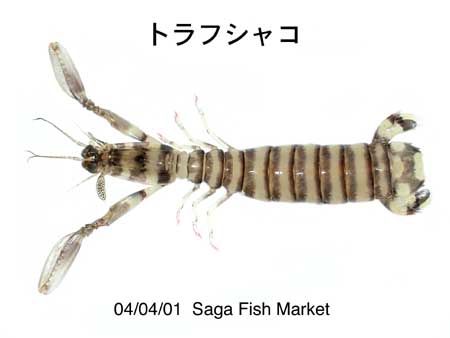
(from M. Nagano's collection)
*I have never seen anyone eat a shako (a squilla, or more commonly known as the mighty mantis shrimp) at kaiten sushi except for Matt. We had to try it at least once, because we believe that you must try everything at a kaiten sushi restaurant at least once. Before I came to Japan, I had no idea that people ate these ferocious beasts
January 19, 2006
For Chris
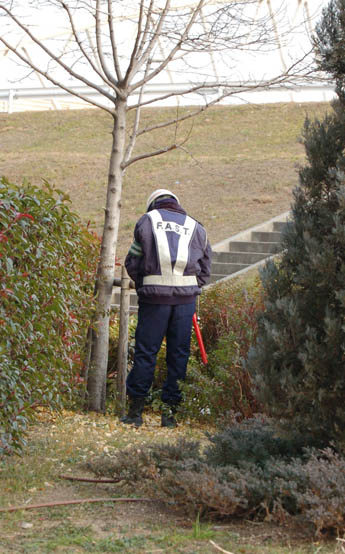
A Japanese law enforcement officer takes a whiz facing the a busy street (invisible from this angle) next to the Yodogawa river. The steady line of traffic that passed by shortly after I snapped this photo must have been able to see him, as he failed to conceal himself behind the taller shrub to his right. Maybe he was just a cosplay urination exhibitionist.
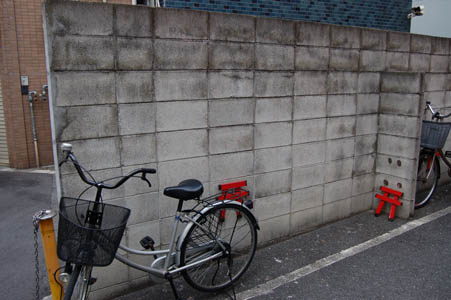
Fun fact: it is socially acceptable to whip it out and take a leak almost anywhere on the streets of Japan, especially if you are an old man.
The only way to prevent this is to put little torii (the red Shinto gate) up in places where you don't want people to piss. Pissing on a torii, as my brother explained, is like pissing on God.
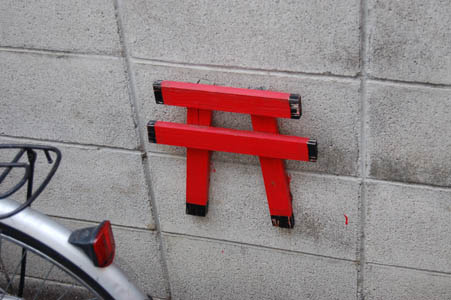
These things apparently work pretty well. Juso, famous for snack bars, colorful non-chain izakayas with an authentic Kansai atmosphere (rivaled only by Shinsekai in my humble opinion), and negiyaki (a type of okonomiyaki, which on a side note I refuse to call a Japanese pizza- who came up with that anyway!) as well as drunk people making their way home from these establishment. The fact that this particular wall does not smell like urine is a testament to the power of the mini torii to ward off those who would otherwise urinate in this area.
Update: Mark has some related pictures up at the Champon Adventures. Thanks dude!
January 18, 2006
Warmer weather
It's been a bit warmer around Osaka lately, and like this semi I've been able to shed down a layer and enjoy the crisp air. Hopefully Spring will come early this year. It's a sad and beautiful thing, to know that this year may well be my last opportunity to enjoy Hanami in Japan. It's a shame that there aren't any cherry trees around the Yodogawa though.
Heh, it's only January and I'm already thinking about drinking under the gentle rain of cherry blossoms...
Update (Jan. 19th, 3:33 PM): Never mind, it's snowing again...
January 17, 2006
Homes of the homeless
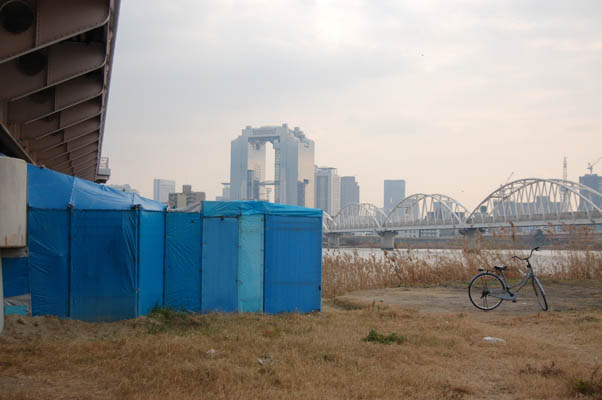
I take these pictures because I truly respect the resourcefulness that these homeless people possess. Using scavenged materials and simple blue tarps, the Yodogawa homeless population has built a community next to the river. By doing so, they have secured themselves one of the best views available in Osaka
The homeless of the Yodogawa don't bother anyone- I have never heard of anyone being molested or even bothered for spare change. Often they hang out, have a couple of drinks, and barbecue. At other times you can see them tending gardens, fishing, practicing their golf, clamming (yes, people do eat clams from the river!), or walking their dogs.
Their dogs are dangerous, though. There are wild packs that roam the banks, and it is best to be wary if you are walking around this area. It is best not to venture out around this area alone, especially at night time, and certainly if you are a female.
Anyhow, for the duration of my stay, I will be posting pictures of these amazing homes as I take them. As I don't want to upset anyone, I'll only be able to take a few at a time or risk being obvious.
Honestly, these homes are amazing- the homeless have accumulated or fabricated everything that they need (refrigerators made out of coolers, outdoor kitchens, and furniture among many other things), and maintain a relatively comfortable life. You can check here for periodic updates.
January 12, 2006
Yodogawa Graffiti Set
Most of the tags that people throw up around the city are ugly and uninspired, but if you look hard enough and explore the less frequented areas you can find some really good stuff. I'll be posting pictures of the better works here, so check back once in a while if you're interested.
January 11, 2006
January 9, 2006
Inoshishi in Kobe
Last year, Huw and I went on a hike through the mountains of Kobe, starting from Ashiyagawa and ending in Shukugawa. Along the way, we saw many signs with wild boars on them, but saw no real wildlife to speak of, only other hikers. This sign stands right in front of the Hankyu train station, warning the people of Ashiya about the dangers of wild boars that sometimes come down from the hills to get run over by BMWs and Mercedes Benzes. If you're going to get run over, Ashiya is definitely the place to do it!
The little kid yells "Dame!" at her dad as he gets attacked as a result of feeding the boar. Ah, this brings back so many colorful childhood memories, notably the one where my dad chased after a female black bear and her cubs in order to snap a picture. I'm just disappointed that he didn't get the picture...
Signs warning hikers against feeding or playing with the boars were more common than one might expect. Personally, if I saw a boar I wouldn't want any part of it after watching Old Yeller but I guess not that many people have seen what happens when you screw with a boar. You either get gored and end up being shot by your best friend, or you kill the boar, eat it, put its head on a stick and worship it as the God of the island. And then you kill Piggy and use his glasses to make fire.
January 8, 2006
Justin and Nam
This is a bit late/early depending on how you look at it, but I wanted to say that I'm really happy for you guys. It seems as if you two have been married for over a decade already to me, so it's fitting after waiting so long that you should get married with such a massive undertaking. Hopefully there will be many more pictures to post later.
